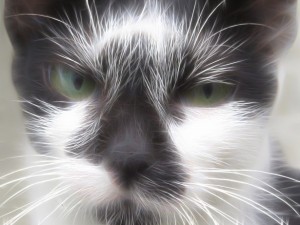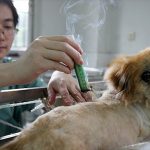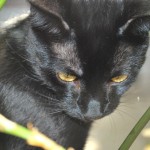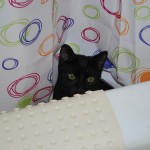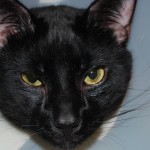The Importance Of Taurine In A Cat’s Diet
If you have a cat you may have heard about the importance of taurine in a cat’s diet. Often, I will browse the internet and read cat health forums and sometimes there’ll be comments posted where pet owners who feed their cat a raw meat diet will add a taurine supplement to the food. Now, this made me wonder: Why are they adding taurine to a raw diet? Or Is it really necessary to add taurine when you feed raw?
Well, before I answer the question, let me explain what taurine is:
Taurine is a sulfur-containing amino acid. But, unlike other amino acids, taurine is not a constituent of any protein. Instead, it exists free in intracellular fluids. It supports neurological development and helps regulate the level of water and mineral salts in the blood. Taurine is also thought to have antioxidant properties.
Health Effects Of A Taurine Deficiency In Cats
For cats, taurine is an essential amino acid that is needed to maintain proper eye and heart function. But it is also found to be important for fetal development, growth, reproduction, neuromodulation, sight, hearing, blood platelet, immune response, antioxidation, and bile acid.
As you can see it effects many important bodily functions. Therefore, a taurine deficiency can cause serious health conditions, such as: blindness, Feline Central Retinal Degeneration (FCRD), Dilated Cardiomyopathy (DCM), heart failure, a poor immune response, poor neonatal growth, deafness, lower number of fetuses, resorptions, abortions, reduced birth weight, low survival rate of newborn kittens, and birth defects, such as, abnormal hind leg development, and skeletal abnormalities that include curved spines and small stature.
Taurine is found in high percentages in the brain, heart, and skeletal muscles of mammals. In the cat, taurine reaches its peak percentages in the total body mass and in the neonatal brain of newborn kittens. But, as the cat matures, taurine decreases about 75% and the remaining 25% is now concentrated in the olfactory bulb and optic nerve, and a few other tissues, such as, the liver.
Taurine is abundant in the tissues of most fish, birds, and rodents, and at lower concentrations in larger animals, such as, bovines (Austrian scientists Friedrich Tiedermann and Leopold Gmelin first identified taurine in 1827 in the bile of an ox. This is where the name comes from,Taurus, the Latin word for bull). However, in the plant kingdom, taurine occurs either in small traces, or not at all. It’s found in red algae, but not in brown or green algae. And, at trace levels in a few plant foods, such as, nuts. Taurine is also present at high levels in insects (no wonder cats love bug hunting).
With the help of a proper diet the human body can make its own supply of taurine. However, it is found that people who are long-term vegans, or vegetarians, have a lower blood count of taurine than those people who eat meat. It is unknown what the long-term effects of depleted taurine is in humans, although some research indicates the nervous system will become over responsive to stress, and other studies are pointing to taurine as an important factor in heart health.
For dogs, taurine is not considered an essential dietary amino acid. And that’s because dogs are able to synthesize sufficient taurine when the Sulphur amino acid precursors, methionine and/or cysteine, are present in adequate amounts in their diet (NOTE: Some breeds of dogs have difficulty producing enough taurine per their body weight and this will lead to a deficiency. For example: the cocker spaniel, golden retrievers, and some giant breeds like the Newfoundland to name a few).
But this is not the case for cats. Our feline friends have a limited capability to make taurine in their bodies (although this blog is about taurine, cats also need the amino acid, arginine, and the fatty acid, arachidonic acid, which cats also cannot make in their bodies). Cats are unable to synthesize their own taurine because of their minimal activity of the enzyme cysteine dioxygenase and cysteine sulfonic acid decarboxylase. So, they must get their taurine requirements from the muscle tissues of their prey. Cats also lose taurine when they defecate since they produce bile acids exclusively from taurine.
A species appropriate diet of raw meaty bones & organs is abundant in taurine (and in arginine and arachidonic acid). However, heat destroys about 2/3rd of the taurine content (some research says heat destroys anywhere between 50%-100% of taurine). Heat also destroys all essential amino acids, enzymes, and a high percentage of micronutrients. This becomes a problem when you feed your kitty a cooked meal whether homemade or processed.
This may come as surprise, but no clinical studies have been done on the daily required allowance of taurine in a cat’s diet. The reason is it can take months, or years, to see the results of a taurine-deficient diet. Therefore, very few dose experiments have been done. However, in the few clinical controlled studies that have been done it was observed that cats given 500mg of taurine per kg of dry matter in their food showed no signs of deficiency. At a higher dose, researchers saw a slight improvement in reproduction. In a 17-month study, cats that were given 375mg of taurine maintained a normal ERG value, as opposed to 250mg which was too low and caused heart abnormalities.
In spite of no long-term studies on feline requirement of taurine, the National Research Council (NRC) specifies that the minimal recommended allowance of taurine for adult cats is 0.0099 kg. per kilogram of body weight. For kittens, they list 0.017 kg. of taurine as the minimum requirement per kilogram of bodyweight and specifies a recommended allowance of 0.33 kg. of taurine per kilogram of body weight. And the AAFCO lists .2% as the minimum for canned/wet foods. This minimum refers to the dry matter percentage that’s in the food.
If the researchers want to see the long-term results of a taurine deficiency in cats then all they need to do is take a look of the work of Dr. Frances Pottenger. From 1932 to 1942, Pottenger conducted a feeding experiment of cooked food vs raw food and its effect on feline health. To summarize his experiment: he divided about 100 cats into two groups: one group was fed raw milk and raw meat, and the other group was fed cooked meats and pasteurized milk. The cats fed raw foods, thrived and reproduced. The cats fed cooked foods, disintegrated in health. They had blindness, heart disease, high mortality rate of kittens, until they failed to reproduce altogether. As you can see, the cats that were fed cooked foods all had the classic symptoms of a taurine deficiency.
(NOTE: Pottenger’s intention wasn’t to study the nutrient requirements of cats, but to prove that “facial deformities” in humans—narrowed jaws, crowded teeth, frail bones, and also difficult pregnancies—was the result of our Western diet of processed foods).
Taurine And Heart Disease In Cats
Earlier this year, I’ve had a couple of clients who came to me with cats suffering from Hypertrophic Cardiomyopathy (HCM), which is a heart disease that causes the thickening of the heart. And, what I found interesting was that both these cats were fed the same brand of a “holistic” processed cat food (how can processed food be holistic? Now that’s what I call an oxymoron!). To me, this was a Red Flag.
And this is why….
Most veterinarians will tell you the cause of HCM is unknown, or that some breeds are predisposed to HCM, but I feel nutrigenomics should be taken into consideration. Nutrigenomics is the study of the effects of foods and food constituents on gene expression. I suspected that this particular brand of cat food may have been deficient in taurine. Although when I checked on the pet food recall page on the FDA website, I didn’t see the brand listed.
Nonetheless, this reminds me of a story from 1988: a cardiology veterinarian student noticed that one of his feline patients he was treating for congestive cardiomyopathy had extremely low blood serum of taurine. Now, this cat was fed one of the so-called best “high quality” “premium” commercial cat food, which according to its label contained all the daily requirement of taurine. This puzzled the veterinarian, so he went back to check other clinical cases of feline congestive cardiomyopathy. And to his amazement, he discovered that virtually all of the cases of this disease had low taurine levels in their blood. When the cats were given a taurine supplement many of them showed a dramatic improvement.
What was going on here? All the cats were eating a “premium” quality commercial cat food that supposedly contained the required levels of taurine! The problem was the taurine was deactivated during the cooking procedure of processing the cat food. You see, pet food manufacturers’ “feeding trails” only last about 6 months. So, if the animal is still alive and appears to be healthy after 6 months then the pet food is approved to sell to the public. However, it takes longer than 6 months to see the effects of a taurine deficiency in a cat. Anyway, because of the discovery by this veterinarian student, the pet food manufacturer corrected their mistake. But I can assure you these nutrient mistakes still occur today. If you don’t believe me, just take a look on the FDA’s website on pet food recalls to see what I’m talking about.
Regarding Taurine Supplements
Now, to answer the question: Is it necessary to add a taurine supplement to raw meat? Well, I already mentioned what happens to vitamins, enzymes, and all the essential amino acids, when meat is cooked…but, with a raw meat diet the concern is the thawing out after its been frozen.
The answer is: There is a slight decrease in taurine when the meat is frozen. However, the longer the meat is frozen, the higher the decrease in taurine. Taurine is water soluble and during the defrosting of meat some water is released. So, the actual meat might end up with a little bit less taurine when thawed. But keep in mind nobody knows the exact amount of taurine that is loss (the numbers were too variable) in defrosted meat. NOTE: This loss of taurine is not caused by freezing but water release with some taurine dissolved in it.
But if you are still concerned about the taurine content in raw meat then I’d suggest the following: Since the highest amount of taurine is present in muscle then be sure to feed your cat muscle meat, and especially hearts (the heart is a muscle).
Let’s take a look at the taurine content of some meats:
Fresh raw rabbit meat has the minimum requirement of natural taurine at .07 percent. And raw chicken has a high taurine level of .12 percent. One ounce of beef liver contains 2.359g taurine per kilogram of dry weight (19mg). And chicken liver contains 6.763g per kilogram of dry weight. One ounce of raw turkey leg has 86 mg. Chicken neck 33.1 mg. A typical mouse will contain 2.4 mg/g taurine or (for better comparison with the other values: 100g would contain 240mg) 4 ounces of a mouse would equal over 2400 mg taurine (However, 2500mg is minimum for a 10-lb cat). So, you see, you don’t have to worry about taurine levels being deficient in raw meat, providing it’s fresh and hasn’t been frozen too long or not at all (NOTE: Taurine is at its highest level in the tiny heart muscle of a mouse).
If you still want to add a taurine supplement to your cat’s food, please remember, it is synthetic and not a natural taurine you are adding. Synthetic taurine is obtained from isethionic acid (2-hydroxyethanesulfonic acid), which in turn is obtained from the reaction of ethylene oxide with aqueous sodium bisulfite. Another approach is the reaction of aziridine with sulfurous acid, which also leads directly to taurine.
Personally, I’d avoid any taurine from China, simply based on their reputation for exporting tainted food products. However, that maybe impossible to do since China is the Number One exporter of synthetic taurine. As of 2010, China alone has more than 40 manufacturers of taurine. Most of these enterprises employ the ethanolamine method to produce a total production of about 3,000 tons per year.
An Important Word About Ground Raw Meat
I’m not a big fan of raw ground meat for several reasons. First, soft, mushy food does not clean the teeth. It’s the actual chomping down on raw bones that scrapes off the tartar. Also, ground raw is not a natural way a cat would eat its prey. Plus, I don’t like the “specialized brands” of ground raw that is sold in pet stores because they all contain fillers like fruit and veggies (not carnivore appropriate food) and added synthetic vitamins. But, more importantly, grinding meat decreases the taurine content. What happens is, grinding increases the surface area of the meat and thus exposes more of the “good stuff” to the air. This results in oxidation of taurine which can result in a decrease in overall available taurine for the cat. Also, because of the exposure to air, grinding can cause a drop in some nutrients, such as, Vitamin E or Vitamin B6. Additionally, grinding creates the perfect environment for bacteria growth, and bacteria also utilize the taurine in the meat, thereby further decreasing the total amount of taurine available to your cat. Thus, if you feed your cat a ground raw diet it may not receive all the taurine it needs to thrive.
For example, researchers at the School of Veterinary Medicine at the University of California conducted a feeding experiment using 22 kittens between the ages of 7 to 20 weeks old. The idea behind the experiment was to see if diet played a role in Inflammatory Bowel Disorder (IBD) and cardiomyopathy. The cats were divided into two groups. One group was fed raw ground rabbit, and the other group was fed commercial cat food. After one week, the researchers noticed the kittens on raw ground rabbit meat had improved stool quality. After one month, the raw fed had firm stools, while the commercial fed kittens had soft to liquid stools. As the experiment continued the raw fed had shiny, soft fur; and the commercial fed, did not. Then by the 10th month, one of the cats who had been eating the ground raw rabbit meat developed dilated cardiomyopathy.
“Moreover, 70% of the remaining raw rabbit diet fed cats, which appeared outwardly healthy, also had heart muscle changes compatible with taurine deficiency and could have developed heart failure if continued on our raw rabbit diet. For the remaining three months of the study, the raw rabbit diet was supplemented with taurine and taurine levels returned to normal.” ~ Angela G. Glasgow, DVM; Nicholas J. Cave, BVSc, MACVSc; Stanley L. Marks, BVSc, PhD, Dip. ACVIM (Internal Medicine, Oncology), Dip. ACVN; Niels C. Pedersen, DVM, PhD, Center for Companion Animal Health, School of Veterinary Medicine, University of California, Davis, California. Read the study HERE.
Mind you, the researchers were feeding the cats only raw ground rabbit meat. As I mentioned above, raw rabbit meat contains the minimum amount of taurine to sustain your cat. Now, add grinding to the equation, plus, freezing and thawing, and taurine falls below the minimum requirement.
I get the impression from reading the above study that the researchers may have been trying to discredit raw feeding to cats by hinting that raw food was not as nutritionally viable as commercial food with its added synthetic taurine. But, the researchers have missed the whole point in feeding raw to our companion felines. The idea behind feeding a species appropriate diet of raw whole prey is to get as close to the cat’s natural diet as possible. The human pet owner can’t match it exactly. It’s not like we’re going to bring home live rabbits and chickens and expect the cat to hunt, kill, and eat the prey in our living room. But, what we can do for our cats is give them a rotation of various whole-solid pieces of fresh meat (rabbits, chicken, turkey, quail, mice, etc.), organs, bones, and limit the length of time the meat is stored in the freezer, and more importantly, do not grind.

